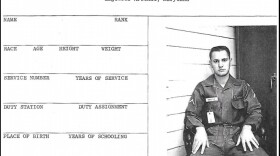Since last year, the Army has required a fitness test before recruits start basic training.
On a chilly morning in south Texas, steam rose off the backs of Army ROTC cadets at St. Mary's University as they performed sit-ups, lunges, and high jump exercises.
The junior-year cadets were less than a week away from taking what the Army calls the OPAT - Occupational Physical Assessment Test. It's like the SAT for people who want to join the Army. If they score high, they can choose jobs that are more physically demanding, like infantry or armor. If they score low, they're limited to less active jobs.
The Army initiated the OPAT last year as a fitness stepping stone before basic training. The idea is for new recruits to build themselves up before they ship out.
Jonathan Molnar, a bespectacled junior, said he feels ready for the test. But it's been hard getting his body into Army-level shape. He played soccer until age 15, but stopped when he reached high school and started work at a fast food chain.
"I took P.E. my freshman year, and after that, there weren't really any requirements," Molnar said. "I moved up to San Antonio my sophomore year and I kind of just vegetated."
The test measures muscular strength and endurance, along with cardio respiratory fitness, explosive power, and speed. Recruits have to pass four different tests: a run, a dead lift, a standing long jump and a power throw.
Seventy percent of people pass the OPAT on the first try, and just about everybody else passes after a few attempts. In 2017, out of more than 69,900 regular Army recruits, only 11 did not achieve the minimum level and chose to be discharged.
Lt. Col. John Lankford, an ROTC instructor at Saint Mary's, said a lot of cadets are surprised by the Army's fitness requirements, even those who come from athletic backgrounds.
"Most of our cadets are from Texas, and most of them have some sort of physical fitness in their past," Lankford said. "But ultimately, the majority of them, once they come into the program, don't understand physical fitness from the Army's perspective."
Lankford said the ROTC program at Saint Mary's focuses on functional fitness and building recruits up gradually so that they don't get hurt.
"We don't train for specific events. We train cadets to develop those core muscles to be physically fit. And all of that translates to their success in the OPAT," he said.
'Get in shape so you can join the Army.'
The Army offers limited help to people who need to pass the OPAT. Recruiters hand out fitness guides and exercise information and sometimes hosts voluntary group workouts. They can hold recruits back from training until they're physically ready.
But the OPAT's real focus is injury prevention, said Michael McGurk, the director for research and analysis at the U.S. Army Center for Initial Military Training.
"We're trying to change attitudes from 'Join the Army and get in shape' to 'Get in shape so you can join the Army.'"
Unfit recruits have plagued the Army in recent years. Before the OPAT, out-of-shape recruits faced a much steeper climb to physical fitness. In just ten weeks of basic training, many had to build muscle and shed pounds, and they often got hurt in the process.
"What we've been working towards is injury prevention," McGurk said. "The more people you get injured, the more the system has to slow down as it compensates for them."
Readiness By Region
In the southeast - the Army's primary recruiting ground - the problem is magnified. Recruits there are less fit than in other states and 28 percent more likely to get hurt , said Citadel researcher Dan Bornstein.
"When you've got that big of a difference, it becomes very significant," he said. "It means that the recruits coming from these states are having a disproportionate impact on the military readiness of the Army."
"Society, and these southern states in particular, are giving the Army lemons and asking them to make lemonade out of those lemons," Bornstein said.
Obesity is souring the Army's recruiting field, with 71 percent of young Americans ineligible to serve in the military. The most common disqualifier is weight, according to a report from the Heritage Foundation.
The Trump administration has asked for more troops, meaning that the Army is now facing a hefty recruitment quota: 80,000 new soldiers by the end of the year.
But for now, the Army is focusing on preventing injuries and safely beefing up the recruits it has. Since the Army starting using the OPAT, it says attrition has gone down 10 percent.
This story was produced by the American Homefront Project, a public media collaboration that reports on American military life and veterans. Funding comes from the Corporation for Public Broadcasting and the Bob Woodruff Foundation.





